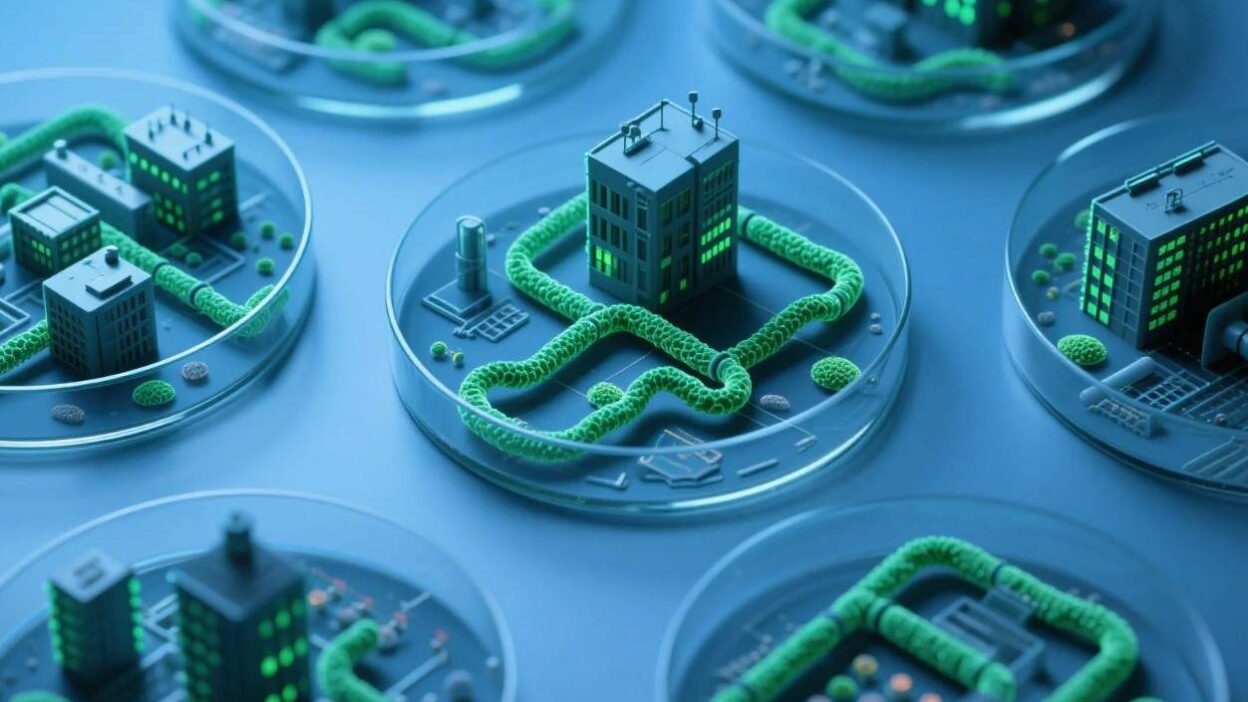Bacteria as Builders of the Future
Traditional infrastructure relies on concrete, steel, and plastic—materials derived from finite resources and energy-intensive processes. Enter microbial cities: a revolutionary concept where engineered bacteria are harnessed to construct, repair, and maintain infrastructure. By merging synthetic biology with civil engineering, these microbial communities transform biology into a building tool, offering sustainable, adaptive, and cost-effective solutions. This report explores how bacteria are being engineered to build the cities of tomorrow.
Engineering Bacteria: The Building Blocks
Microbial cities depend on synthetic biology—tailoring bacteria to perform specific tasks. Key steps include:
- Strain Selection: Bacteria like E. coli, Bacillus subtilis, or Synechococcus (cyanobacteria) are chosen for their hardiness, rapid growth, or ability to secrete useful compounds.
- Genetic Modification: CRISPR-Cas9 and other gene-editing tools enhance bacterial capabilities. For example:
- Material Production: Bacteria are engineered to secrete biopolymers (e.g., polyhydroxyalkanoates) or enzymes that catalyze concrete curing.
- Sensing & Response: Genes are added to make bacteria react to environmental cues (e.g., pH, temperature) to trigger construction.
- Community Design: Bacteria are assembled into consortia, where different strains specialize in tasks like material synthesis, structural support, or waste breakdown.
Applications: Building Beyond Concrete
Microbial cities are already being tested in diverse infrastructure projects:
1. Self-Healing Concrete
Engineered bacteria (e.g., Bacillus) are embedded in concrete to repair cracks. When exposed to water, they secrete limestone (calcium carbonate), sealing gaps and extending the material’s lifespan. A 2022 study showed such concrete repaired 90% of cracks within 24 hours, reducing maintenance costs by 30%.
2. Bioremediation Infrastructure
Bacteria are used to clean polluted sites. For example, Pseudomonas putida is engineered to degrade oil or heavy metals in contaminated soil, turning toxic waste into harmless byproducts. This “living infrastructure” can be deployed in industrial zones or former mines.
3. Space Habitat Construction
NASA and private firms (e.g., Biomason) are exploring bacteria to build lunar or Martian habitats. Cyanobacteria, for instance, can produce oxygen and organic compounds from Martian regolith, while engineered Bacillus strains solidify soil into bricks, reducing reliance on Earth-supplied materials.
4. Smart Urban Systems
Microbial communities are integrated into smart grids. Bacteria programmed to respond to air quality (e.g., detecting CO₂) can activate green infrastructure (e.g., algae-based air filters) in real time, improving urban sustainability.
Challenges and Risks
While promising, microbial cities face hurdles:
- Survival & Scalability: Bacteria must thrive in diverse environments (e.g., extreme temperatures, radiation) and scale from lab experiments to large infrastructure projects.
- Regulatory Gaps: No global framework governs releasing engineered bacteria into ecosystems, raising concerns about unintended ecological impacts (e.g., disrupting local microbiomes).
- Ethical Concerns: Public perception of “living infrastructure” may spark fears about control (e.g., bacteria acting unpredictably) or equity (e.g., access to microbial tech in low-income regions).
The Future: Bacteria as Urban Partners
The future of microbial cities hinges on innovation and collaboration:
- Advanced Engineering: Developing bacteria that produce stronger, lighter materials (e.g., biodegradable plastics) or self-assemble into complex structures.
- Policy Frameworks: Governments must establish guidelines for microbial infrastructure, including safety testing and environmental impact assessments.
- Community Engagement: Involving local stakeholders in designing microbial projects ensures solutions align with community needs (e.g., flood-resistant infrastructure in coastal cities).
A Bacterial Revolution in Construction
Microbial cities represent a paradigm shift—where biology, not just steel and concrete, builds our future. By engineering bacteria to construct, repair, and adapt infrastructure, we unlock sustainability, resilience, and innovation. As research advances, these microbial communities could redefine urban development, proving that even the smallest organisms can build big solutions.



